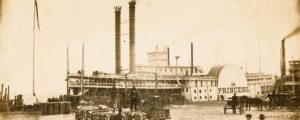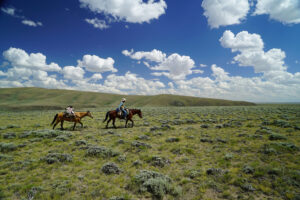Visionary F.E. Warren became the ‘John Wanamaker of Wyoming’.
Francis Emroy Warren was the most gifted entrepreneur in 19th-century Cheyenne, and he became the wealthiest man in Wyoming. At the apex of his career he built the Warren Emporium, bringing the emerging department store to Cheyenne and introducing the newfangled concept of recreational shopping to the West. The young Civil War veteran (Corporal Warren received a Medal of Honor for rushing “the enemy’s works under a heavy fire” at the 1863 Siege of Port Hudson in Louisiana) had arrived in Cheyenne in 1868, the year after the founding of the railroad boomtown. Although raised on a hardscrabble Massachusetts farm, Warren proved an ambitious, visionary urban pioneer.
Starting out as a clerk in a Cheyenne furniture store, Warren later bought the business, then acquired real estate and built commercial and residential structures. Soon he was collecting $30,000 in annual rents alone. And he built a ranching empire: The Warren Livestock Co. held property across much of Wyoming, as well as in Colorado and Nebraska. On his ranches Warren ran cattle, horses and vast numbers of sheep.
In March 1884 a fire destroyed Warren’s principal mercantile outlet, a brick building adjacent to the Inter-Ocean, Cheyenne’s primary hotel. Warren, who incurred some $250,000 in losses and collected just $90,000 in insurance, immediately announced plans to rebuild at a new location, a half block north of the busy Union Pacific Depot, kitty-corner from the Inter-Ocean. Warren commissioned architect J.S. Matthews to design a business headquarters that would cover almost an entire block of prime real estate and feature one of the West’s most impressive retail palaces.
Warren knew that the Industrial Revolution had enabled the production of affordable retail goods in mass quantity, and such innovative merchant kings as A.T. Stewart and R.H. Macy of New York, John Wanamaker of Philadelphia and Marshall
Field of Chicago had exploited that fact to develop successful urban department stores.The widespread availability of merchandise in turn transformed shopping habits. Field, for example, catered to the moneyed women of Chicago with elegant surroundings that encouraged a leisurely, recreational shopping experience. Field’s Chicago was the nearest major city to Cheyenne and was a frequent destination for upper-class citizens of the “Magic City of the Plains,” and Warren incorporated many of the latest retail developments into his business. The Warren Mercantile Co. bought merchandise by the railcar load, delivering to stores across Wyoming and beyond. Warren was keenly aware of the many well-to-do women in Cheyenne with plenty of time to engage in recreational shopping, not to mention the many idle tourists drawn by the frequent goings-on in Wyoming’s capital. Less affluent customers of the Warren Mercantile could buy on credit, paying in monthly or weekly installments. In Cheyenne the wives of Union Pacific Railroad employees or of Army officers from nearby Fort D.A. Russell or of local clerks could shop in the emporium and buy, on such newfangled credit terms, otherwise unaffordable items. Warren also provided pianos, organs and sewing machines “at reasonable terms of rental.”
Construction crews built the sprawling Warren Emporium in just over five months at an approximate cost of $80,000. As the builders purchased most of their materials and supplies locally and also hired local carpenters, masons and other laborers, nine-tenths of the building cost reportedly went into the hands of Cheyenne citizens. The crews used 13,500 cubic feet of stone for the foundation and 300,000 bricks and 1,500 square feet of heavy plate glass for the main structure. The building ran 180 feet along 16th Street (Cheyenne’s main business thoroughfare) and 132 feet along Hill Street, facing the three-story Phoenix Block (which Warren had erected in 1882). The entire frontage along Hill (later Capitol) comprised a continuous line of plate glass show windows, and a 60-by-15-foot skylight further illuminated the display rooms. The facade rose 50 feet above street level, and three towers climbed even higher.
Counting its spacious cellar, the emporium boasted 52,000 square feet of floor space. The east side of the building held three floors of workrooms and storage, while the west side featured the large, bright display rooms and galleries. The elevator had a capacity of 3,500 pounds and was, according to one source, “fitted up with safety clutches so that heavyweight passengers may make a trip on it without fear.” A sidetrack allowed railroad freight cars to enter the south side of the immense building and space was provided for loading and unloading delivery wagons. Twelve-foot-wide “elegant walkways” along the north and west frontages included 18,000 square feet of flagstone.
The Warren Emporium opened in late October 1884. Warren, already a proponent of newspaper advertising, took out a full-page local ad:
THE WARREN EMPORIUM IS NOW FULLY COMPLETED AND IS BEYOND QUESTION THE LARGEST AND MOST COMPLETE MERCANTILE ESTABLISHMENT IN THE WEST. IT IS FULLY STOCKED WITH SELECTED GOODS BOUGHT IN VERY LARGE QUANTITIES.
The rest of the page listed available goods in the various departments.
The emporium showcased the most attractive of these goods behind the long row of plate glass windows. The principal entrance led through a 52-foot-tall clock tower on the northwest corner of the store, looking out on the Inter-Ocean. Customers entered across the tile floor of a hexagonal vestibule to behold miscellaneous goods, arrayed on the main floor and the galleries above. Individual managers supervised each department—furniture, carpets, sewing machines, pianos and music, wallpaper and pictures, glassware and china, etc. Headlines in The Cheyenne Daily Leader trumpeted that the emporium offered a BEWILDERING DISPLAY OF PRETTY ARTICLES FOR THE LADIES and that sales were MADE BY THE SINGLE DOLLAR OR BY THE THOUSAND. The paper reported that the second floor of the entry tower“is fitted up with an elegant carpet, piano and other furniture and will be used as a reception and waiting room for the pleasure and convenience of the customers,” and that customers also had “elegantly fitted up toilet apartments, provided with hot and cold water and all modern conveniences.”
Cheyenne already boasted an excellent business section, and no town of similar size (7,000 people in 1884) in the country had anything like the Warren Emporium. The Daily Leader crowed, “Mr. Warren may well be called the A.T. Stewart or the John Wanamaker of Wyoming.” Warren’s richly furnished private office at the emporium featured a fireplace bordered with “illuminated tiles.” Adjoining offices housed the Warren Mercantile Co. managerial staff and, in a separate suite, the Warren Live Stock Co., with telephone connections to the firm’s 14 ranches. This office complex was the nerve center of an empire that included the mercantile operation, big-scale ranching, real estate and investments.
There was little more for Warren to accomplish in the business world of Cheyenne or ranching world of Wyoming. He was wealthy and had a loving wife, a little girl and a baby boy. But Warren was too young and ambitious to remain satisfied long. His political gifts were as formidable as his business talents, and he set out to accomplish something in high office. In 1890 he was elected Wyoming’s first governor, and for nearly 40 years he served as a U.S. senator. But the crown jewel of Warren’s entrepreneurial genius was the emporium, where Cheyenne’s leading businessman introduced his 19th-century customers to the shopping habits of the next century.
Originally published in the February 2012 issue of Wild West. To subscribe, click here.




